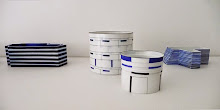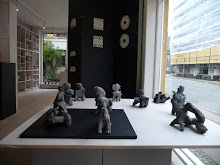

PETER BRANDES - OSTRACA Potsherds
Exhibition 26 April - 9 June 2018
OSTRACA - An artist's throw of dice with the visible and invisible.


Peter Brandes focuses on ceramics - history, archaeology, contemporary..
from potsherds to ceramic paintings, vessels - and democracy.





Ostracism = written in, Greek poll conducted on potsherds.
Ostracon is a piece of pottery, usually broken off from a vase or other earthenware vessel. Ostraca refer (in ancient Greece) to potsherd, especially one used as a ballot, where a vote was inscribed.

The central point of the exhibition is ceramic fragments used as notebooks, sketches, referenda and much more, - and also presenting new painted jars by the renowned Danish fine artist.
A poetic fragmented puzzle about ceramics, art and philosophy.










PETER BRANDES is a significant Danish visual artist who works in many materials and disciplines. He was early on fascinated by clay, but emerges as a ceramic artist from the late 1980s, and has since created a number of pieces from extensive commissions, freestanding sculptures, church interiour and small-scale works such as jars and dishes to monumental jars in collaboration with the Tommerup Ceramic Workshop. www.keramos.dk
In series of works, he explores the possibilities of ceramic material in relation to drawing, graphics, book art, photography with a fine feel for materials and processes. The themes revolve around classical antiquity and the Jewish and Christian imagery.
OSTRACA - by Peter Brandes
Clay is a part of the Earth, it is the fire as well, if you go far enough into the Earth's interior.
In a ceramic kiln I can get these two elements to meet, so to speak.
The boundary where the interior of the earth meets the outer surface of the earth is the field where a metamorphosis occurs and earth and fire become ceramics.

 In my family, it is now the fifth generation, who has a brickyard in Vedstårup at Funen, and in my childhood I saw with respect and admiration into a tunnel-kiln's clay and fire.
In my family, it is now the fifth generation, who has a brickyard in Vedstårup at Funen, and in my childhood I saw with respect and admiration into a tunnel-kiln's clay and fire. That was probably the beginning of my amazement and love for ceramics.
I have done small and huge vases, figures, reliefs and plates especially in the Tommerup Ceramic Workshop and in transition also at the Royal Copenhagen Porcelain Factory.

 This small exhibition has a title: Ostraka, the Greek word for potsherds.
This small exhibition has a title: Ostraka, the Greek word for potsherds.Around the year 480 BC, Athens was a major city and filled with potsherds. When the plates or vases had broken, shards piled up huge waste stacks here and there, and people got the idea to use these shards to scratch messages or names.
It became those day's yellow memorabilia, the paper was not yet invented.
 When dawn of Greek democracy originated in the early 480 BC, for the first time in our cultural history, a majority decision was made to determine who was losing and who was winning.
When dawn of Greek democracy originated in the early 480 BC, for the first time in our cultural history, a majority decision was made to determine who was losing and who was winning. The vote took place in the way that in a potsherd was incised the name of a candidate. It could be one to be exiled or one selected for a position.
Thus arose the first ballot boxes and the democratic form of voting was after the potsherd named ostracism.
Democracy was linked to broken pottery. A potsherd was recycled.
Egyptian visual artists and architects used to the greatest extent also the potsherds to outline impressions, expressions and images.



Thorvald Bindesbøll, Scandinavia's most significant ceramist, had for a while the younger painter and ceramist Svend Hammershøi as an assistant. He tells in his little memory book: Thorvald Bindesbøll in Memoriam that "Bølle" owned a large collection of potsherds set in a wooden box under his bed in the family apartment on Vesterbro. They were collected with the friend and painter August Jerndorff in the muddy soil from the canals of The embankmens in Copenhagen when they were drained before the turn of the century (1900). For generations, scratched or broken ceramic objects were thrown into the canals and now appeared to the attentive collector who Bindesbøll was.

 Potsherds that I and my wife have collected for years are like part of a whole that is no more.
Potsherds that I and my wife have collected for years are like part of a whole that is no more.This initiates the imagination and the natural desire, as a puzzle, assembling the pieces to reach an overall picture or form.
Seen as fragmentation, these shards in itself hold a monumental force that precisely in the lack of a completed statement are open to numerous interpretations.
I am convinced that one of Bindesbøll's great inspiration source, on the path to his ornamental wealth, is the enigma of the potsherd.





For many years, I have on the remains of ceramic sheets recorded or scratched impressions. With coloured clay if the piece was unfired or glazes if it was fired.
That way, new potsherds or Ostraca originated as fragments in themselves from the beginning. An involuntary chosen form as a starting point and a derivative of other ideas than if it was a defined form like a vase or a dish.







At this exhibition in the gallery's intimate space, I hope that these smaller shards will appear as they were the node drafts from a musician or written words from an author.
This is a case of refined ceramic expressions. A painter's dice game with experiences from one's visible and invisible surroundings.
PPETER BRANDES was born in 1944 in Assens, Denmark. He is a painter, graphic artist, sculptor and photographer. Has illustrated a number of books, including Homers Illiaden and INANNA, retelling of Suzanne Brøgger
Artistic breakthrough in the 1980s at the Galerie Moderne, Silkeborg, Denmark.
Peter Brandes' ceramic works, which among others include giant jars, are often carried out in collaboration with the Tommerup Ceramic Workshop. keramos.dk
Grateful thanks to The Danish Art Foundation for project funding in 2018.
 PETER BRANDES OSTRAKA Potsherds 2018
PETER BRANDES OSTRAKA Potsherds 2018In connection with the exhibition at Ann Linnemann Gallery in 2018, a Danish catalogue will be published, which includes the above images and text by Peter Brandes.
BIOGRAPHY
SELECTED EXHIBITIONS
Decembristerne 1978-80; Danish Graphic artists 1980-81, 1983-84, 1989; Da. Grafik, Nat.mus., Sth. 1980; Billedkunst. Hvordan..., Vejle Art Museum 1982-83; Grønningen 1984-88 (medl. fra 1985), 1990-93; Bien. der europäischen Graphik, Baden-Baden 1985; FIAC, Paris 1986-87; Ny da. glaskunst, Centre Internat. du Vitrail, Chartres 1988; Da. billedkunstnere fotograferer, Mus. for Fotokunst 1989; Art Cologne, Köln 1989; Basel Art Fair 1990-91; Verdensudst., Sevilla 1992. Separatudstillinger: Kerteminde Bibl. 1969; Satyricon Arlequiniania, Gal. Westing, Odense 1970; Breve fra Nordafrika, smst. 1971; Tema og variationer, Haderslev Mus. 1972; Ainigma, Kunstnernes egen Kunsthdl., Kbh. 1975, 1979; Erindringsbilleder, Sønderjyll. Kunstmus. 1976; Gal. Schiang, Odense 1977; Mus. des Beaux Arts, Lille 1979; Som følge af Kong UBU, Glyptoteket m.fl. 1980; Det Hellige Victoria Bjerg, Gal. Specta, Århus 1981; Glyptoteket 1982 (fotografi); Før Naxos efter, Randers Kunstmus. m.fl. 1983; Gal. Specta 1984; Fortid, Glyptoteket 1986; Det da. Hus, Paris 1988 (s.m. Poul Pedersen); Omkring en skulptur, Trapholt 1988-89; Køge Skitsesaml. 1989; Kunsthallen, Kbh. 1990; Gal. der Spiegel, Köln 1990, 1993; Gal. Ariel, Paris 1991; P.B. og antikken, Brandts Klædefabrik 1991; Fortid II, Mus. for Fotokunst m.fl. 1991-92; Talbot Rice Gal., Edinburgh 1992; Grafik og keramiske arbejder, Sophienholm 1993; endvidere en række udstillinger i Galerie Moderne, Silkeborg.
FUNDS AND AWARDS
Statens Kunstfond 1977-78, Det 3-årige stipendium 1982; 1.Pr. på grafikbien. i Baden-Baden 1985; Det Rønnenkampske Legat 1985; Rockwool Pr. 1986; Ole Haslund 1986. m.fl.









































































































